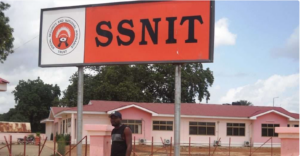ACRR Views on ILO Actuarial Valuation Report of SSNIT
ACRR Views on ILO Actuarial Valuation Report of SSNIT Home Blog ACRR Views on ILO Actuarial Valuation Report of SSNIT Latest News and Events ACRR Views on ILO Actuarial Valuation Report of SSNIT Media Reporting on scheme sustainability ACRR Participates at the JoyNews National Pension Policy Dialogue Evaluating the Social and Financial Cost of the SSNIT Policy not to Accept Contributions from Workers Aged 60 and above– Forced Retirement ACRR Petitions the National Pension Regulatory Authority Pensions in payment projected to go up by at least a fixed rate of 20% in 2023– ACRR Social Protection: Extent of Achievement of UN Sustainable Development Goals in Sub-Saharan Africa Pension Reforms in Sub-Saharan Africa– Impact of Changes in Demography and Economy. Latest News and Events latest news ACRR Views on ILO Actuarial Valuation Report of SSNIT latest news Media Reporting on scheme sustainability latest news ACRR Participates at the JoyNews National Pension Policy Dialogue latest news Evaluating the Social and Financial Cost of the SSNIT Policy not to Accept Contributions from Workers Aged 60 and above – Forced Retirement latest news ACRR Petitions the National Pension Regulatory Authority latest news Pensions in payment projected to go up by at least a fixed...
Evaluating the Social and Financial Cost of the SSNIT Policy not to Accept Contributions from Workers Aged 60 and above – Forced Retirement
Think-tank Africa Center for Retirement Research (ACRR) has taken a dig at the Social Security and National Insurance Trust (SSNIT) for its recent policy to disallow 60-year-olds and above from contributing to the scheme.ACRR described the policy as a disaster, calling for its immediate reversal. This was contained in a statement issued by Executive Director Abdallah Mashud on Monday, March 6. Mr Mashud gave seven reasons why the policy is a disaster. “The policy if not reversed will adversely affect the success of the Trust’s effort to extend pension coverage to self-employed workers. You May Also Like Democracy Hub protest: Felicity Nelson writes from prison to support #FreeTheCitizens protest Paramount Chief of Lower Axim shuts illegal mine Mahama Ayariga files RTI request to demand information on Next-Gen InfraCo deal from Communication Minister 3-day protest for release of Democracy Hub members underway PAC refers two schools to Attorney-General for prosecution “SSNIT as a purely Social Insurance Scheme must consider the policy as one that will considerably affect the retirement wellbeing of thousands of workers, and therefore will require thorough examination and even an amendment to Act 766 for implementation.” Find the statement below: The Social Security and National Insurance Scheme (SSNIT)...
ACRR Petitions the National Pension Regulatory Authority
ACRR Petitions the National Pension Regulatory Authority
Pensions in payment projected to go up by at least a fixed rate of 20% in 2023 – ACRR
January is the most important time of the year for pensioners and their dependents, primarily because it is when the Social Security Administration announces the new rates by which monthly pensions of existing retirees will be increased. The import of indexation is to restore the purchasing power lost by pensioners in the previous year. Pensions in payment are therefore reviewed by applying an inflation-adjusted index. It is therefore expected that SSNIT in consultation with the National Pensions Regulatory Authority (NPRA) will soon announce the new pension indexation rate for 2023. How is the Pension Indexation Provision Applied by SSNIT? Pension indexation (as provided in section 80 of Act 766), as a means of restoring the purchasing power lost by pensioners in the previous year, is largely dependent on the price inflation index. In practice, SSNIT uses consumer price inflation as the main variable for increasing pensions. The Trust, in consultation with the Board of the National Pensions Regulatory Authority, agrees on what is termed as the ‘Overall Rate’ by which pensions will increase for the coming year. The overall indexation rate is based on the analysis of several variables which include in particular the projected increase in the cost of...
Social Protection: Extent of Achievement of UN Sustainable Development Goals in Sub-Saharan Africa
Social Protection: Extent of Achievement of UN Sustainable Development Goals in Sub-Saharan Africa
Pension Reforms in Sub-Saharan Africa – Impact of Changes in Demography and Economy.
Pension Reforms in Sub-Saharan Africa – Impact of Changes in Demography and Economy.







